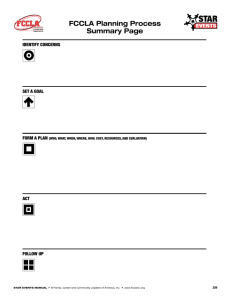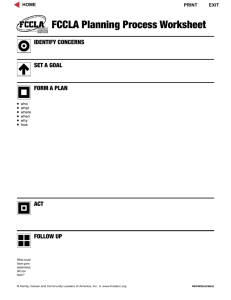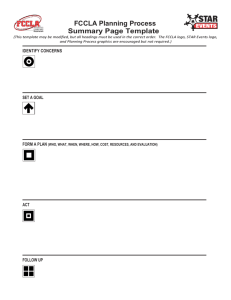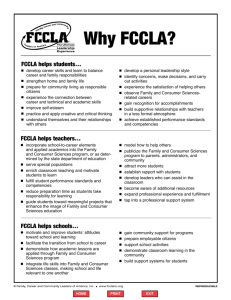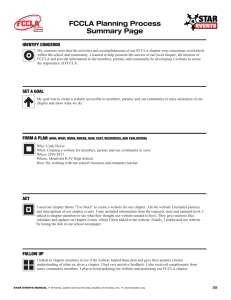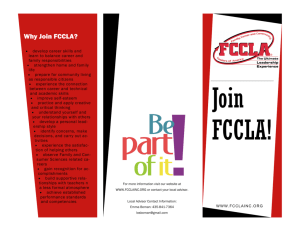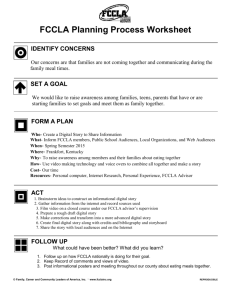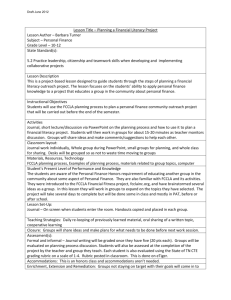2015 Leadership Development
advertisement
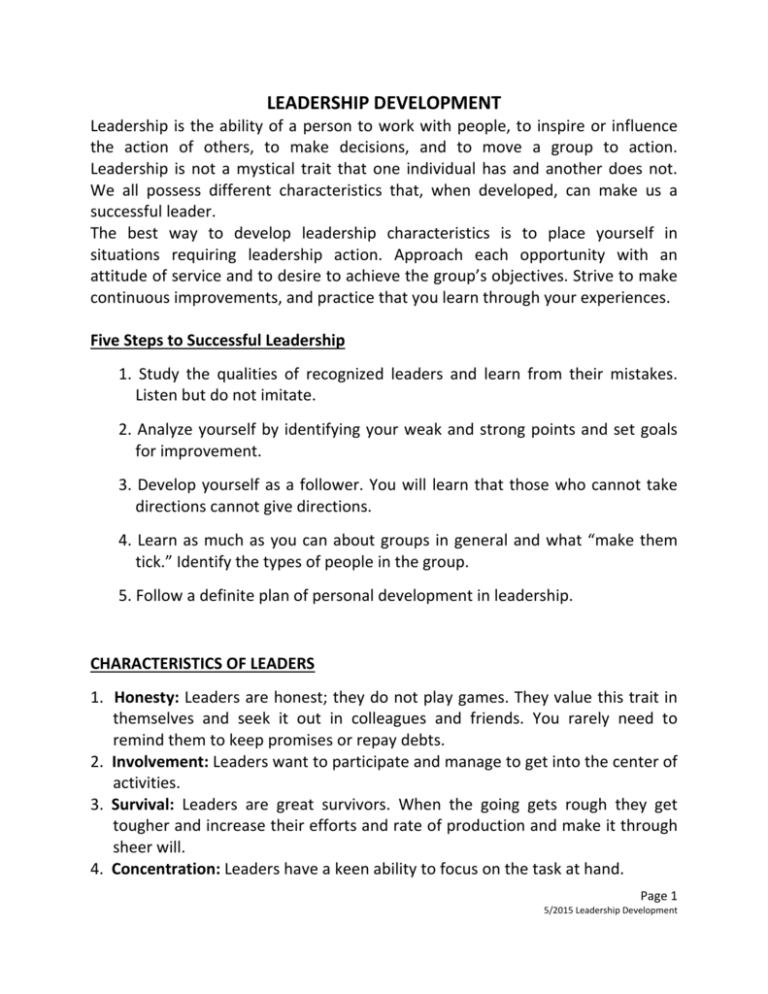
LEADERSHIP DEVELOPMENT Leadership is the ability of a person to work with people, to inspire or influence the action of others, to make decisions, and to move a group to action. Leadership is not a mystical trait that one individual has and another does not. We all possess different characteristics that, when developed, can make us a successful leader. The best way to develop leadership characteristics is to place yourself in situations requiring leadership action. Approach each opportunity with an attitude of service and to desire to achieve the group’s objectives. Strive to make continuous improvements, and practice that you learn through your experiences. Five Steps to Successful Leadership 1. Study the qualities of recognized leaders and learn from their mistakes. Listen but do not imitate. 2. Analyze yourself by identifying your weak and strong points and set goals for improvement. 3. Develop yourself as a follower. You will learn that those who cannot take directions cannot give directions. 4. Learn as much as you can about groups in general and what “make them tick.” Identify the types of people in the group. 5. Follow a definite plan of personal development in leadership. CHARACTERISTICS OF LEADERS 1. Honesty: Leaders are honest; they do not play games. They value this trait in themselves and seek it out in colleagues and friends. You rarely need to remind them to keep promises or repay debts. 2. Involvement: Leaders want to participate and manage to get into the center of activities. 3. Survival: Leaders are great survivors. When the going gets rough they get tougher and increase their efforts and rate of production and make it through sheer will. 4. Concentration: Leaders have a keen ability to focus on the task at hand. Page 1 5/2015 Leadership Development 5. Optimism: Leaders are optimistic people who back up their predictions by planning. They recognize excellence in others and are quick to offer compliments. 6. Confidence: Leaders trust their own potential. They believe they make their own luck through long hours of work and preparation. 7. Creativity: Leaders are creative people who maintain a high level of productivity throughout their lives. Their mental capacity improves with time. 8. Aiming High: Leaders aim for the very best; they do not settle for anything less. 9. Opportunism: Leaders find the channels where information flows. They recognize options and opportunities and act on them. 10. Planning: Leaders not only make everything look as good as possible, as fast as possible, and as efficiently as possible, but they plan ahead. (Prior proper planning prevents poor performance!) 11. Dressing for Success: High achievers dress for success; they attend to appearance, and they notice the details about appropriate dress codes. 12. Directness: Leaders are noted for their direct, open approach and their eye‐ to‐eye contact. 13. Making Changes: The careers and lifestyles of leaders are not fixed in granite. They know how to makes changes. They seek out new learning situations. 14. Competitiveness: Leaders are strivers. If competition comes their way, they recognize that true competition begins within one’s self. 15. Learning from Models: Leaders learn by watching others who are successful and identifying qualities they would like to develop. 16. Organization: Good leaders are organized. They pay attention to details and write down responsibilities. 17. Finishing: Leaders are finishers who get the job done. They can follow instructions without misunderstanding and enhance the quality of their tasks by adding something unexpected that improves the results. Additional Characteristics of an FCCLA Leader 1. Believe in FCCLA and have a sincere desire to serve the organization. Be a team player. 2. Study the history, goals, and purposes of FCCLA. Learn about the bylaws of the chapter and develop respect for the organization’s strong heritage. 3. Be willing to speak on behalf of the organization. Develop speech material about FCCLA and practice speaking skills. Page 2 5/2015 Leadership Development 4. Learn the opening and closing ceremonies and know parliamentary procedure. Contribute to the success of chapter meetings by providing ideas, reports, and discussion. 5. Be outgoing and willing to meet people. 6. Have a personal code of ethics and conduct yourself in a manner becoming to FCCLA. Remember, when you look and act good, your organization looks great! 7. Be effective in time management. Learn to write activity dates in a personal calendar and be on time to all events. 8. Be courteous. The words” please” and “thank you” pay dividends. Use them often. 9. Encourage those around you. Look for the good qualities in others, and be a “people builder.” 10. Believe in yourself! Recognize your importance to the organization! Be enthusiastic, energetic, patient, positive, cooperative, and humble. Above all, be your best self! The “Youth‐Centered Leadership” Concept The concept of “Youth‐Centered Leadership” recognizes that each member contributes to the chapter’s growth and success. Decisions are made by the group. Members and officers share in planning, implementing, and evaluating chapter work. FCCLA programs, both formal and informal are learning experiences that meet the varied needs, interests, and learning styles of members. Members learn through FCCLA experiences by being actively involved in planning projects that are relevant to them. FCCLA uses a planning process that enables members to do just that. The Planning Process* Five Step Process There are five steps to the planning process. For certain projects or chapter actions, some steps may repeat themselves, overlap or be skipped. Students can use the planning process in sorting out thoughts, analyzing situations, and making definite plans toward a specific goal. It not only has immediate benefits for chapter action but also can help students throughout life as they make decisions and set priorities based on their concerns. Page 3 5/2015 Leadership Development Symbol Interpretation Five symbols represent the planning process steps. To understand and remember the process, consider how the symbols graphically portray each step. Chapter members can discuss their own interpretations of the symbols as a warm‐up project planning. Here are some ideas to get started. Identify Concerns The circle, like a continuous flow of ideas, has no beginning and no end. As a target, it symbolizes zeroing in on one idea around which the chapter would like to build a project. Set your goal The arrow stands for deciding which direction the chapter will take. It points toward the goal or end result. Form a Plan The square represents the coming together of ideas – the who, where, what, when, and how of the plan. Act The different squares in this symbol represent the varied activities to be carried out to meet the goal. It represents putting one’s self into the plan and acting on it. Follow Up The broken squares suggest examining the project piece by piece. This symbol also represents a “window” through which to look and evaluate the plan. Page 4 5/2015 Leadership Development Rules for Brainstorming 1. List every idea 2. Do not discuss 3. Do not judge 4. Repetition is okay 5. Enjoy the silences Page 5 5/2015 Leadership Development
